TOYOTA PRIUS 2018 (in English) Manual PDF
Manufacturer: TOYOTA, Model Year: 2018, Model line: PRIUS, Model: TOYOTA PRIUS 2018Pages: 820, PDF Size: 15.63 MB
Page 71 of 820
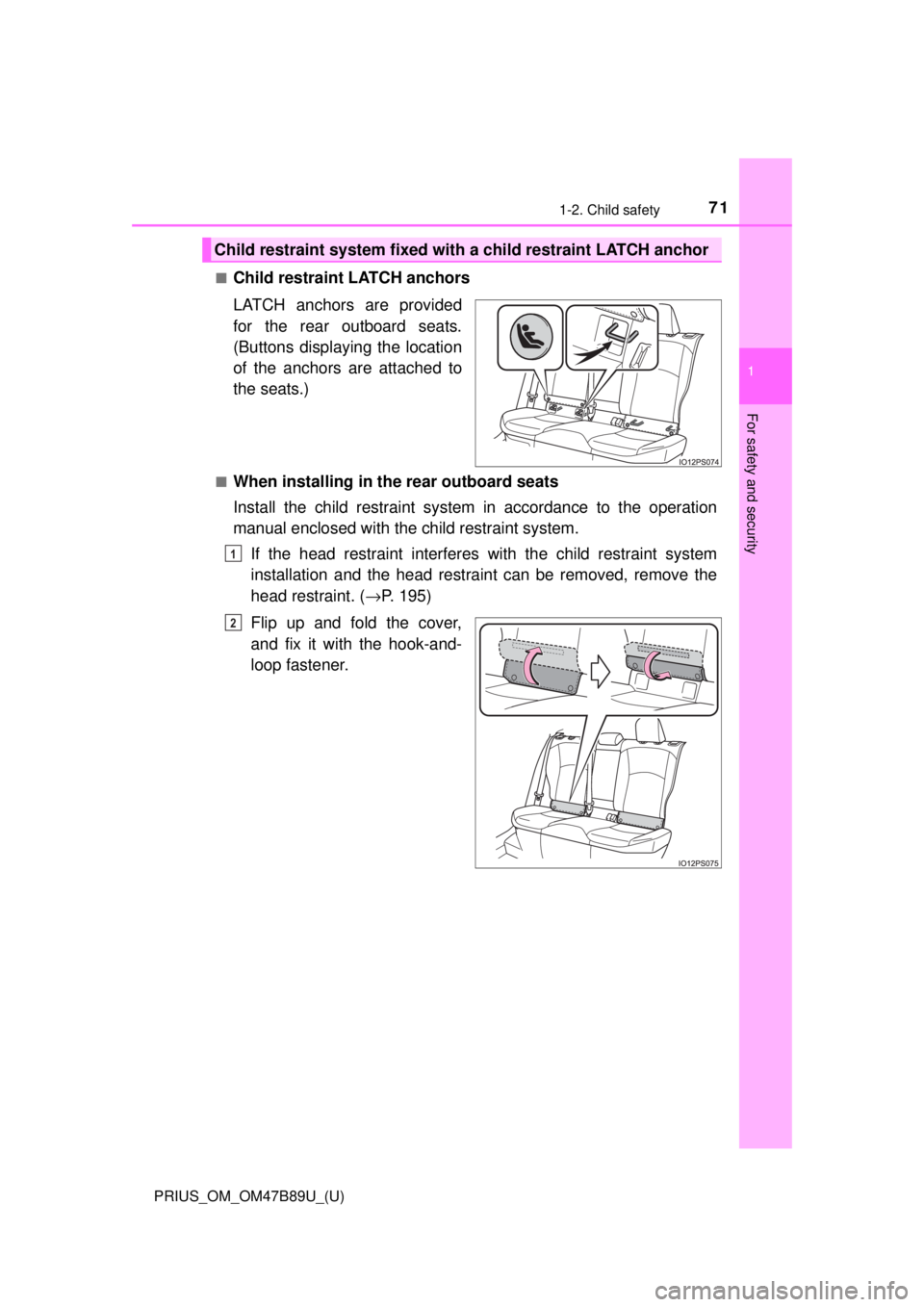
711-2. Child safety
PRIUS_OM_OM47B89U_(U)
1
For safety and security
■Child restraint LATCH anchors
LATCH anchors are provided
for the rear outboard seats.
(Buttons displaying the location
of the anchors are attached to
the seats.)
■When installing in the rear outboard seats
Install the child restraint system in accordance to the operation
manual enclosed with the child restraint system.If the head restraint interferes with the child restraint system
installation and the head restraint can be removed, remove the
head restraint. ( →P. 195)
Flip up and fold the cover,
and fix it with the hook-and-
loop fastener.
Child restraint system fixed with a child restraint LATCH anchor
1
2
Page 72 of 820
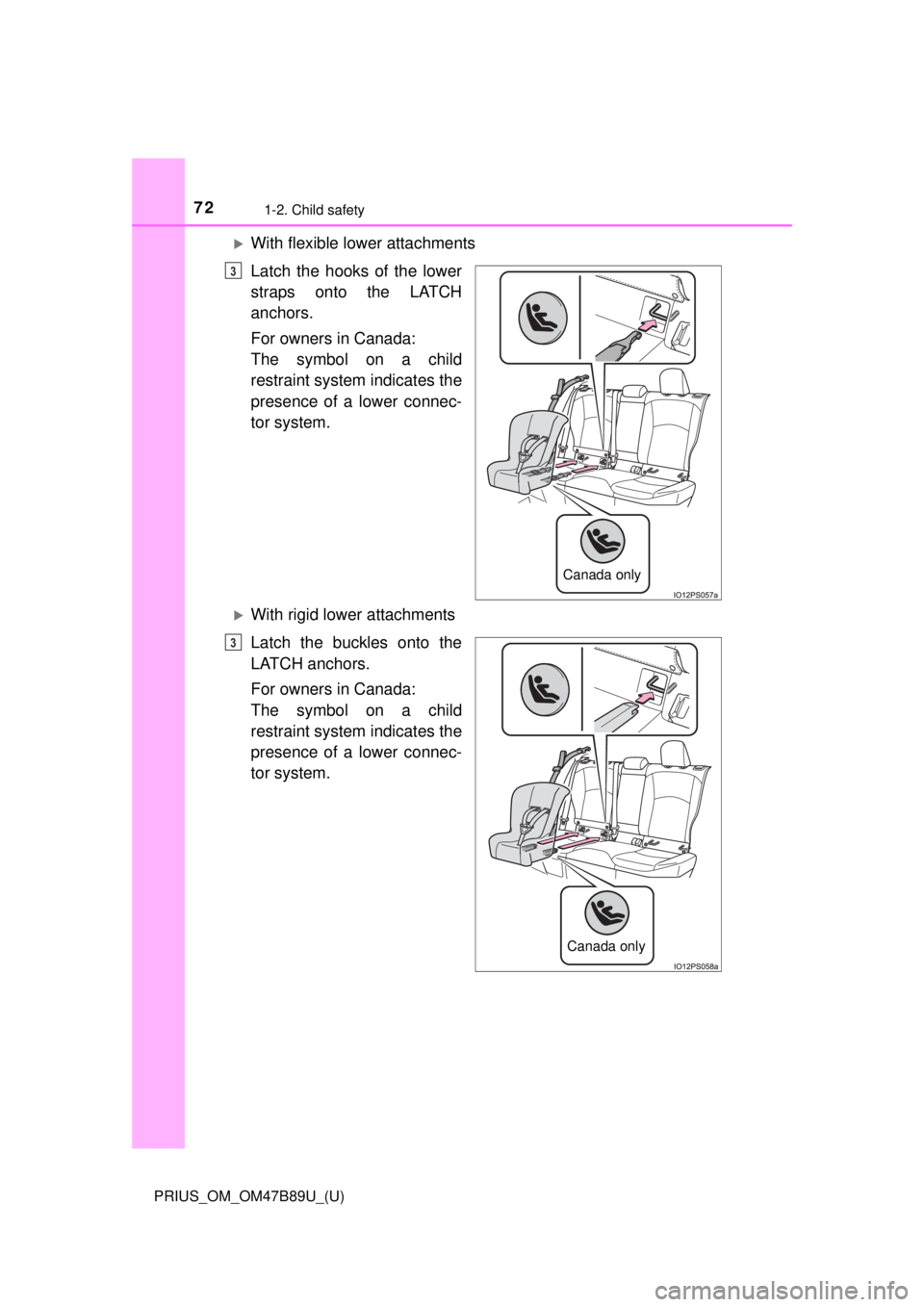
721-2. Child safety
PRIUS_OM_OM47B89U_(U)
With flexible lower attachments
Latch the hooks of the lower
straps onto the LATCH
anchors.
For owners in Canada:
The symbol on a child
restraint system indicates the
presence of a lower connec-
tor system.
With rigid lower attachments
Latch the buckles onto the
LATCH anchors.
For owners in Canada:
The symbol on a child
restraint system indicates the
presence of a lower connec-
tor system.
Canada only
3
Canada only
3
Page 73 of 820
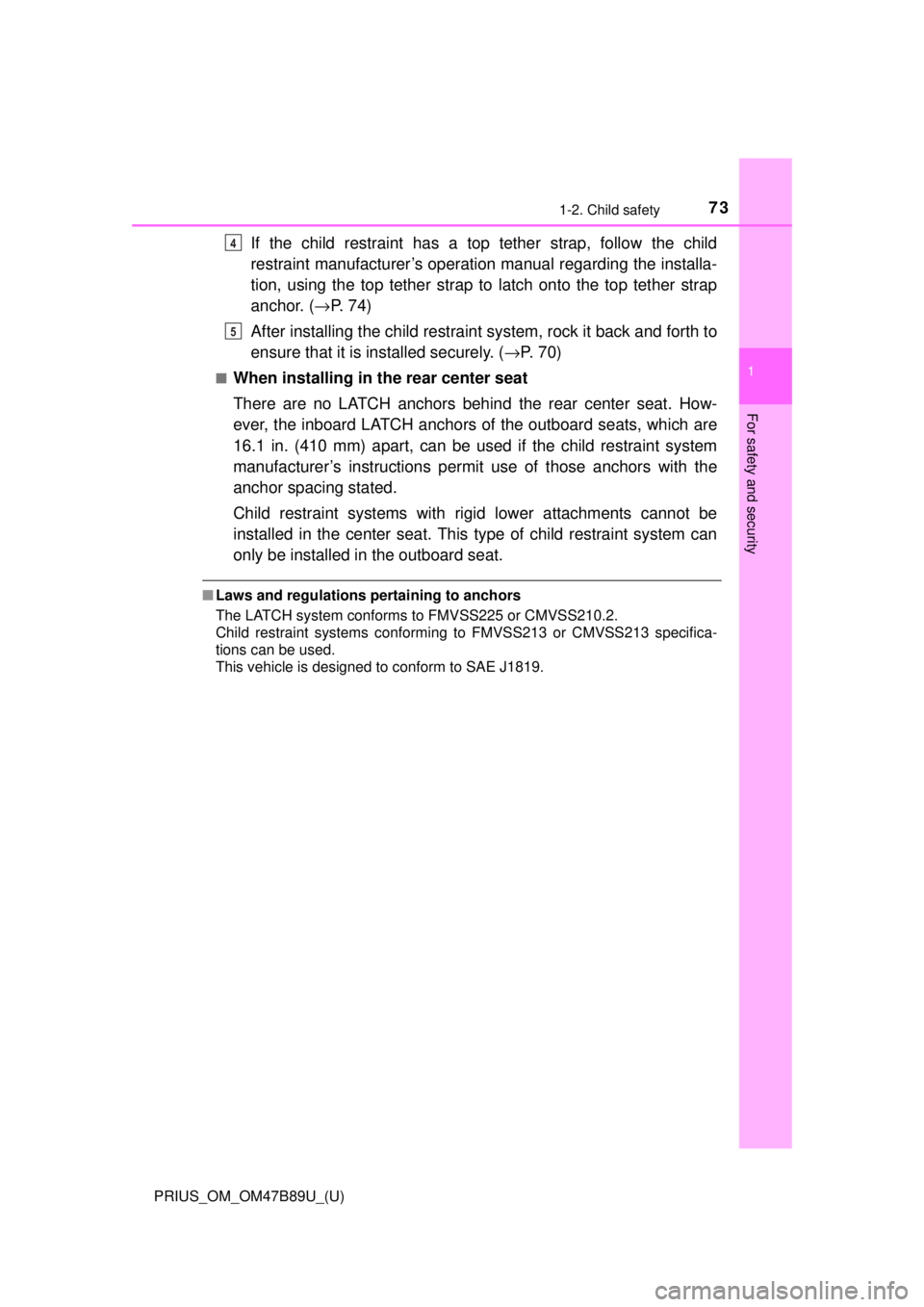
731-2. Child safety
PRIUS_OM_OM47B89U_(U)
1
For safety and security
If the child restraint has a top tether strap, follow the child
restraint manufacturer’s operation manual regarding the installa-
tion, using the top tether strap to latch onto the top tether strap
anchor. (→ P. 7 4 )
After installing the child restraint system, rock it back and forth to
ensure that it is installed securely. ( →P. 70)
■When installing in the rear center seat
There are no LATCH anchors behin d the rear center seat. How-
ever, the inboard LATCH anchors of the outboard seats, which are
16.1 in. (410 mm) apart, can be used if the child restraint system
manufacturer’s instructions permi t use of those anchors with the
anchor spacing stated.
Child restraint systems with ri gid lower attachments cannot be
installed in the center seat. This type of child restraint system can
only be installed in the outboard seat.
■ Laws and regulations pertaining to anchors
The LATCH system conforms to FMVSS225 or CMVSS210.2.
Child restraint systems conforming to FMVSS213 or CMVSS213 specifica-
tions can be used.
This vehicle is designed to conform to SAE J1819.
4
5
Page 74 of 820
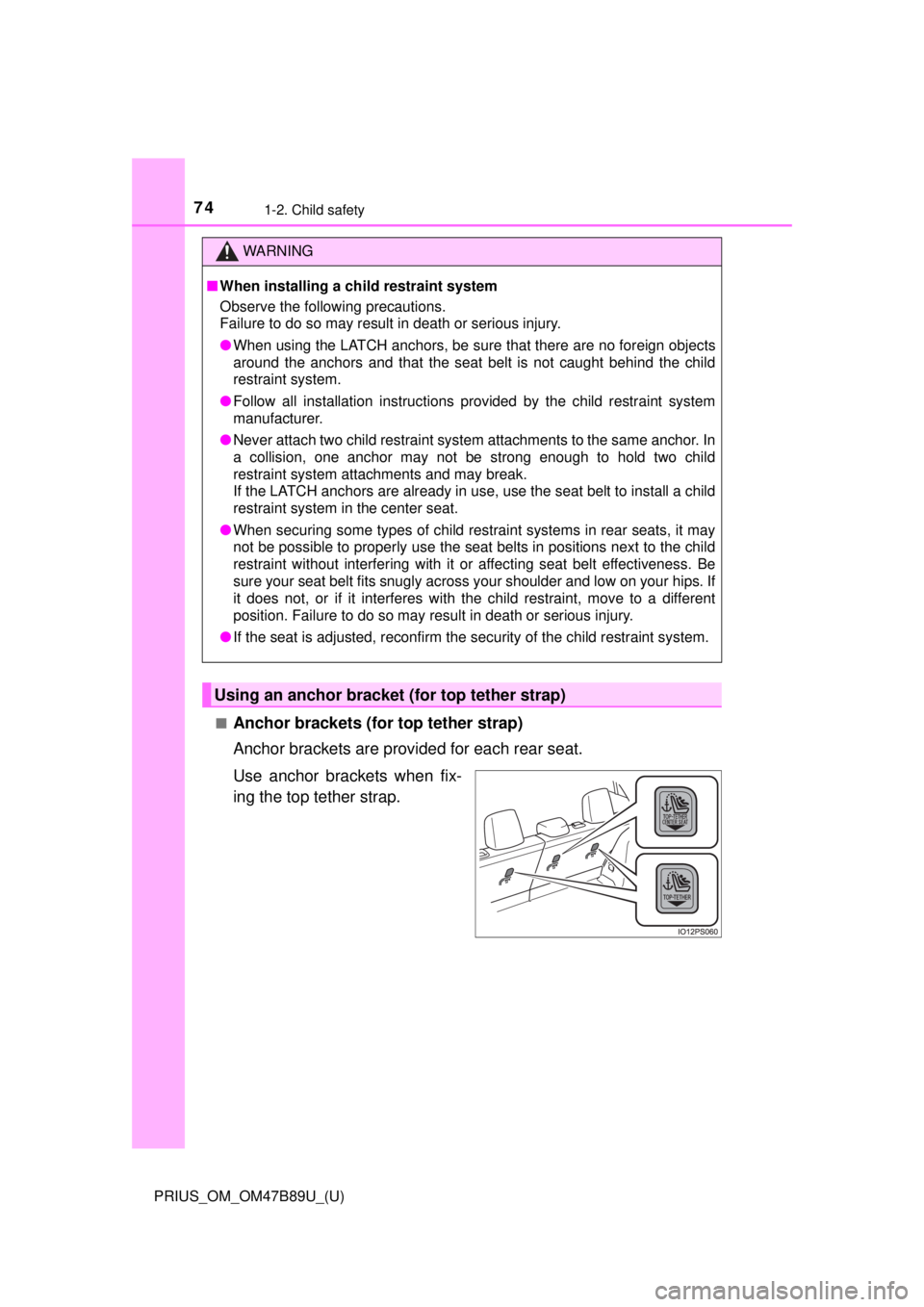
741-2. Child safety
PRIUS_OM_OM47B89U_(U)■
Anchor brackets (for top tether strap)
Anchor brackets are provided for each rear seat.
Use anchor brackets when fix-
ing the top tether strap.
WARNING
■
When installing a child restraint system
Observe the following precautions.
Failure to do so may result in death or serious injury.
● When using the LATCH anchors, be sure that there are no foreign objects
around the anchors and that the seat belt is not caught behind the child
restraint system.
● Follow all installation instructions provided by the child restraint system
manufacturer.
● Never attach two child restraint system attachments to the same anchor. In
a collision, one anchor may not be strong enough to hold two child
restraint system attachments and may break.
If the LATCH anchors are already in use, use the seat belt to install a child
restraint system in the center seat.
● When securing some types of child restraint systems in rear seats, it may
not be possible to properly use the seat belts in positions next to the child
restraint without interfering with it or affecting seat belt effectiveness. Be
sure your seat belt fits snugly across your shoulder and low on your hips. If
it does not, or if it interferes with the child restraint, move to a different
position. Failure to do so may result in death or serious injury.
● If the seat is adjusted, reconfirm the security of the child restraint s\
ystem.
Using an anchor bracket (for top tether strap)
Page 75 of 820
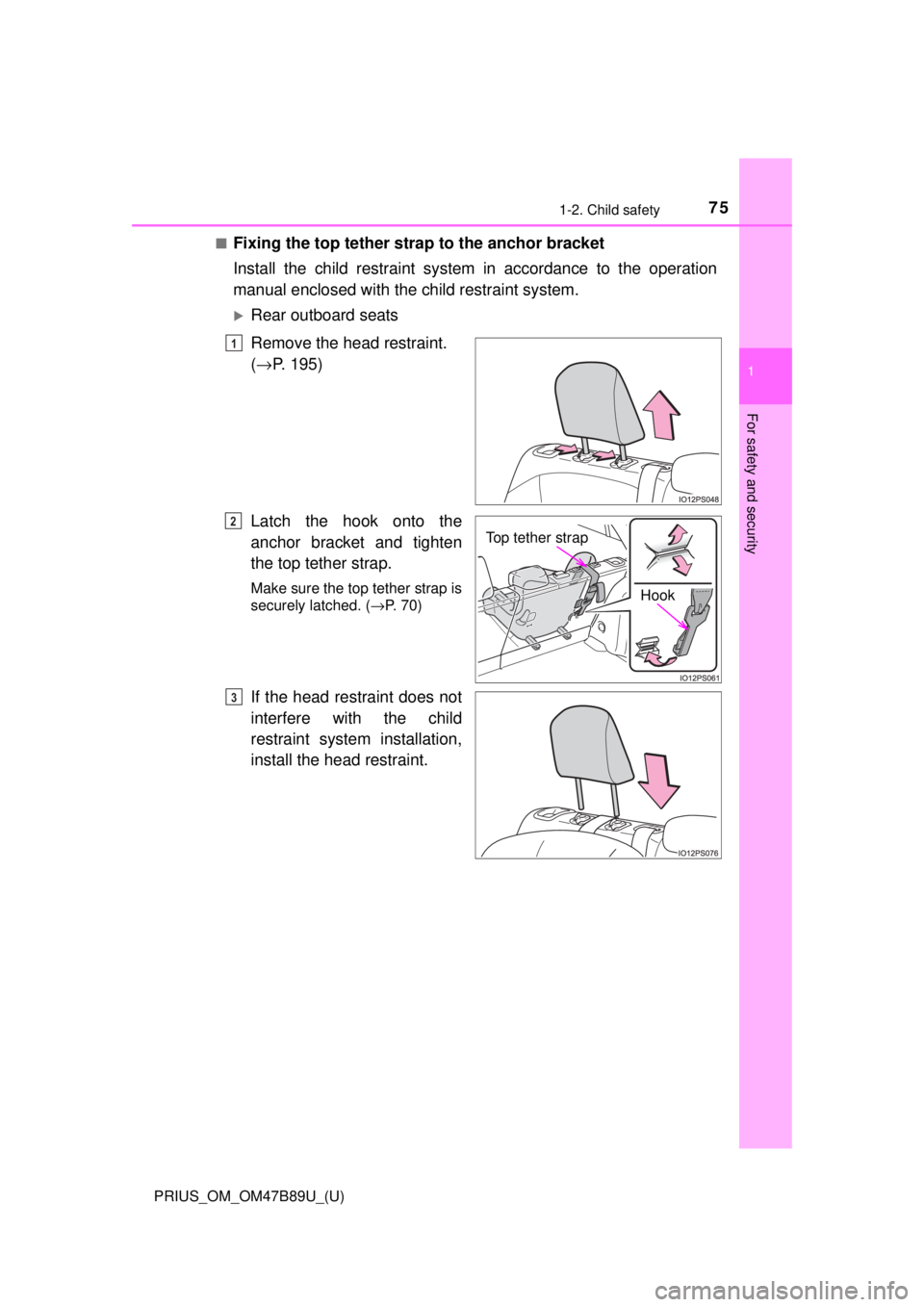
751-2. Child safety
PRIUS_OM_OM47B89U_(U)
1
For safety and security
■Fixing the top tether strap to the anchor bracket
Install the child restraint system in accordance to the operation
manual enclosed with the child restraint system.
Rear outboard seats
Remove the head restraint.
(→ P. 195)
Latch the hook onto the
anchor bracket and tighten
the top tether strap.
Make sure the top tether strap is
securely latched. ( →P. 70)
If the head restraint does not
interfere with the child
restraint system installation,
install the head restraint.
1
Hook
Top tether strap
2
3
Page 76 of 820
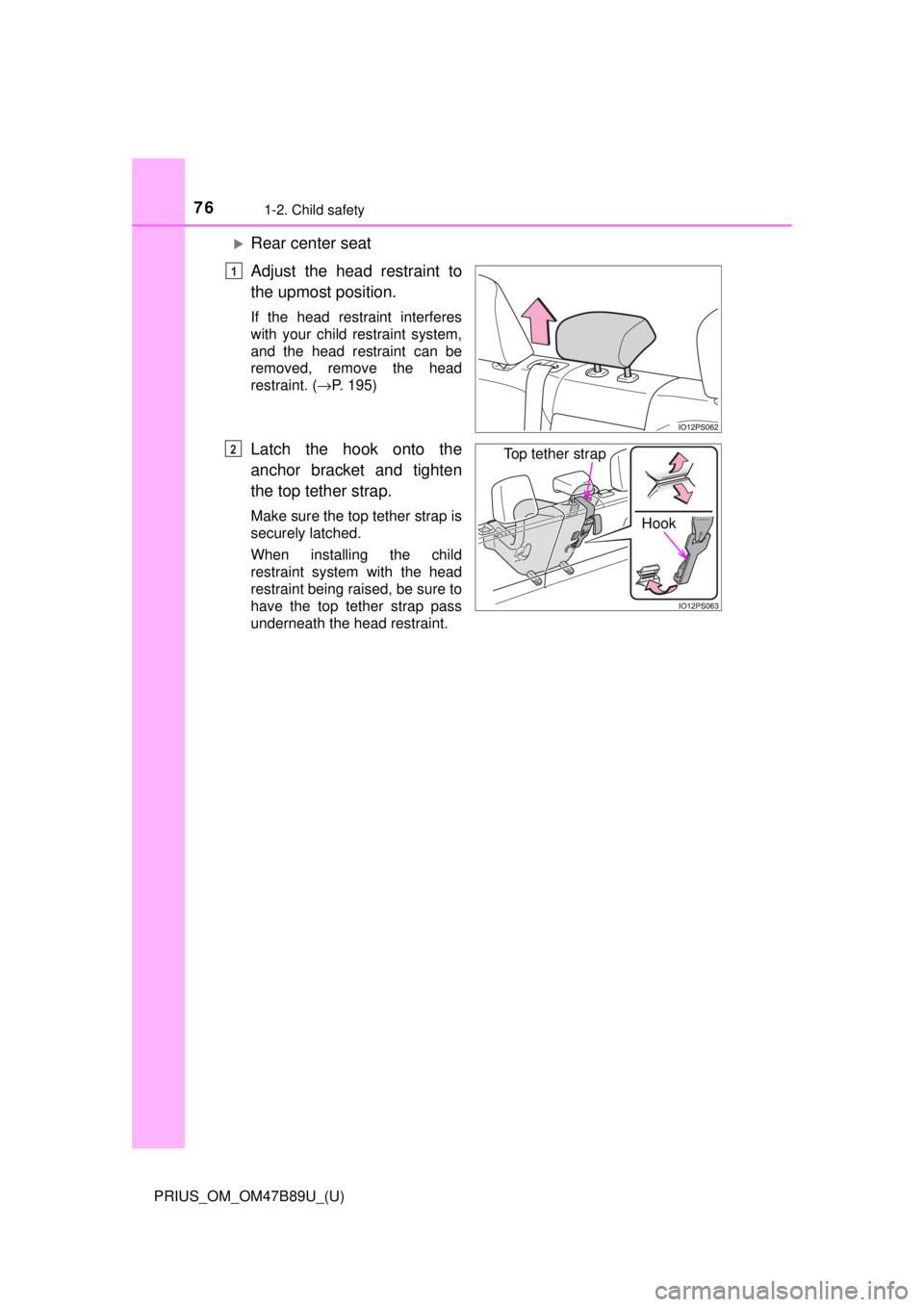
761-2. Child safety
PRIUS_OM_OM47B89U_(U)
Rear center seat
Adjust the head restraint to
the upmost position.
If the head restraint interferes
with your child restraint system,
and the head restraint can be
removed, remove the head
restraint. (→P. 195)
Latch the hook onto the
anchor bracket and tighten
the top tether strap.
Make sure the top tether strap is
securely latched.
When installing the child
restraint system with the head
restraint being raised, be sure to
have the top tether strap pass
underneath the head restraint.
1
Hook
Top tether strap2
Page 77 of 820
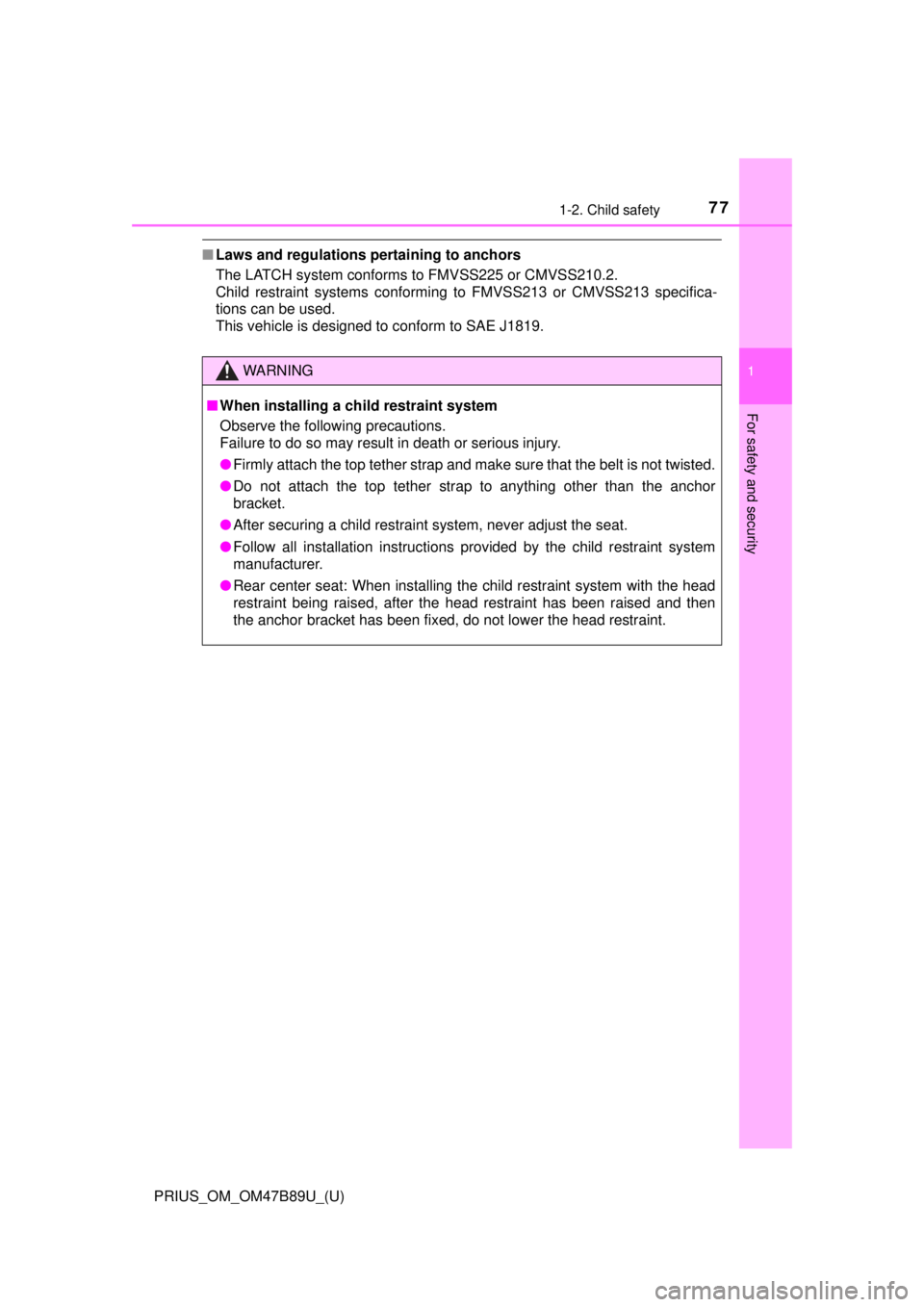
771-2. Child safety
PRIUS_OM_OM47B89U_(U)
1
For safety and security
■Laws and regulations pertaining to anchors
The LATCH system conforms to FMVSS225 or CMVSS210.2.
Child restraint systems conforming to FMVSS213 or CMVSS213 specifica-
tions can be used.
This vehicle is designed to conform to SAE J1819.
WARNING
■When installing a child restraint system
Observe the following precautions.
Failure to do so may result in death or serious injury.
● Firmly attach the top tether strap and make sure that the belt is not twisted.
● Do not attach the top tether strap to anything other than the anchor
bracket.
● After securing a child restraint system, never adjust the seat.
● Follow all installation instructions provided by the child restraint system
manufacturer.
● Rear center seat: When installing the child restraint system with the head
restraint being raised, after the head restraint has been raised and then
the anchor bracket has been fixed, do not lower the head restraint.
Page 78 of 820
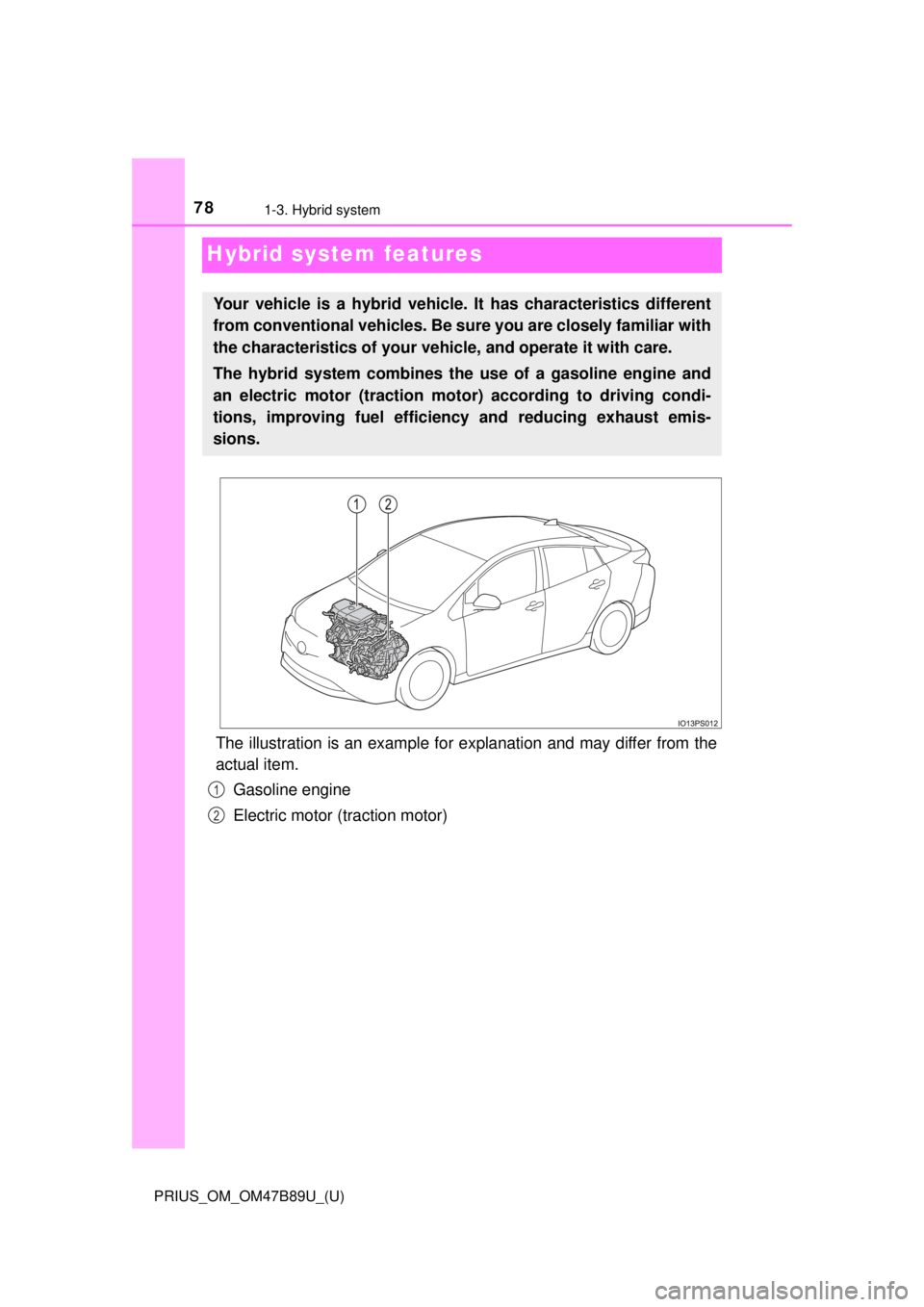
781-3. Hybrid system
PRIUS_OM_OM47B89U_(U)
Hybrid system features
The illustration is an example for explanation and may differ from the
actual item.
Gasoline engine
Electric motor (traction motor)
Your vehicle is a hybrid vehicle. It has characteristics different
from conventional vehicles. Be sure you are closely familiar with
the characteristics of your vehicle, and operate it with care.
The hybrid system combines the use of a gasoline engine and
an electric motor (traction moto r) according to driving condi-
tions, improving fuel efficien cy and reducing exhaust emis-
sions.
1
2
Page 79 of 820
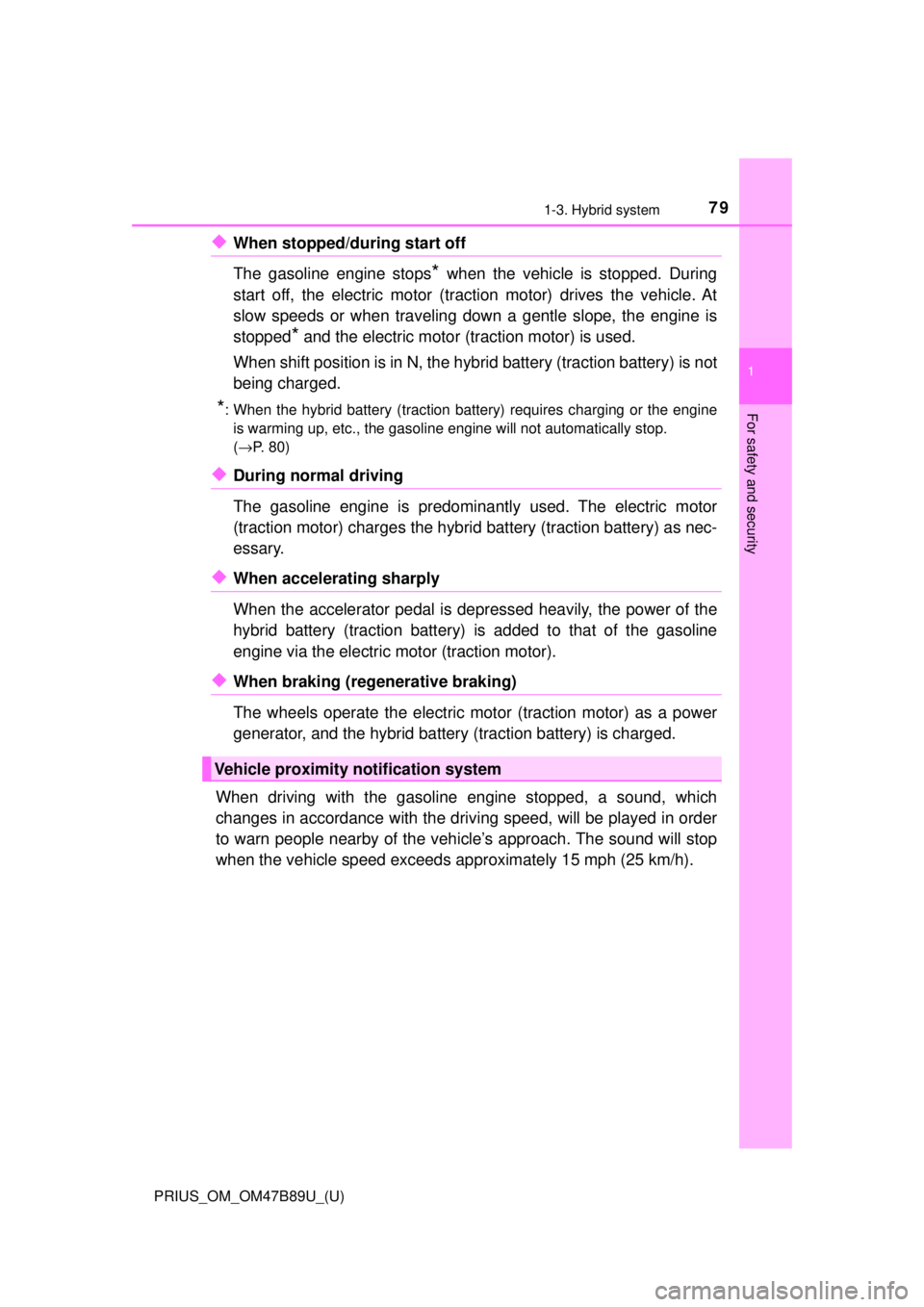
791-3. Hybrid system
PRIUS_OM_OM47B89U_(U)
1
For safety and security
◆When stopped/during start off
The gasoline engine stops
* when the vehicle is stopped. During
start off, the electric motor (traction motor) drives the vehicle. At
slow speeds or when traveling down a gentle slope, the engine is
stopped
* and the electric motor (traction motor) is used.
When shift position is in N, the hybrid battery (traction battery) is not
being charged.
*: When the hybrid battery (traction battery) requires charging or the engine is warming up, etc., the gasoline engine will not automatically stop.
(→P. 80)
◆During normal driving
The gasoline engine is predomin antly used. The electric motor
(traction motor) charges the hybrid battery (traction battery) as nec-
essary.
◆When accelerating sharply
When the accelerator pedal is depressed heavily, the power of the
hybrid battery (traction battery) is added to that of the gasoline
engine via the electric motor (traction motor).
◆When braking (regenerative braking)
The wheels operate the electric motor (traction motor) as a power
generator, and the hybrid battery (traction battery) is charged.
When driving with the gasoline engine stopped, a sound, which
changes in accordance with the driving speed, will be played in order
to warn people nearby of the vehi cle’s approach. The sound will stop
when the vehicle speed exceeds approximately 15 mph (25 km/h).
Vehicle proximity notification system
Page 80 of 820
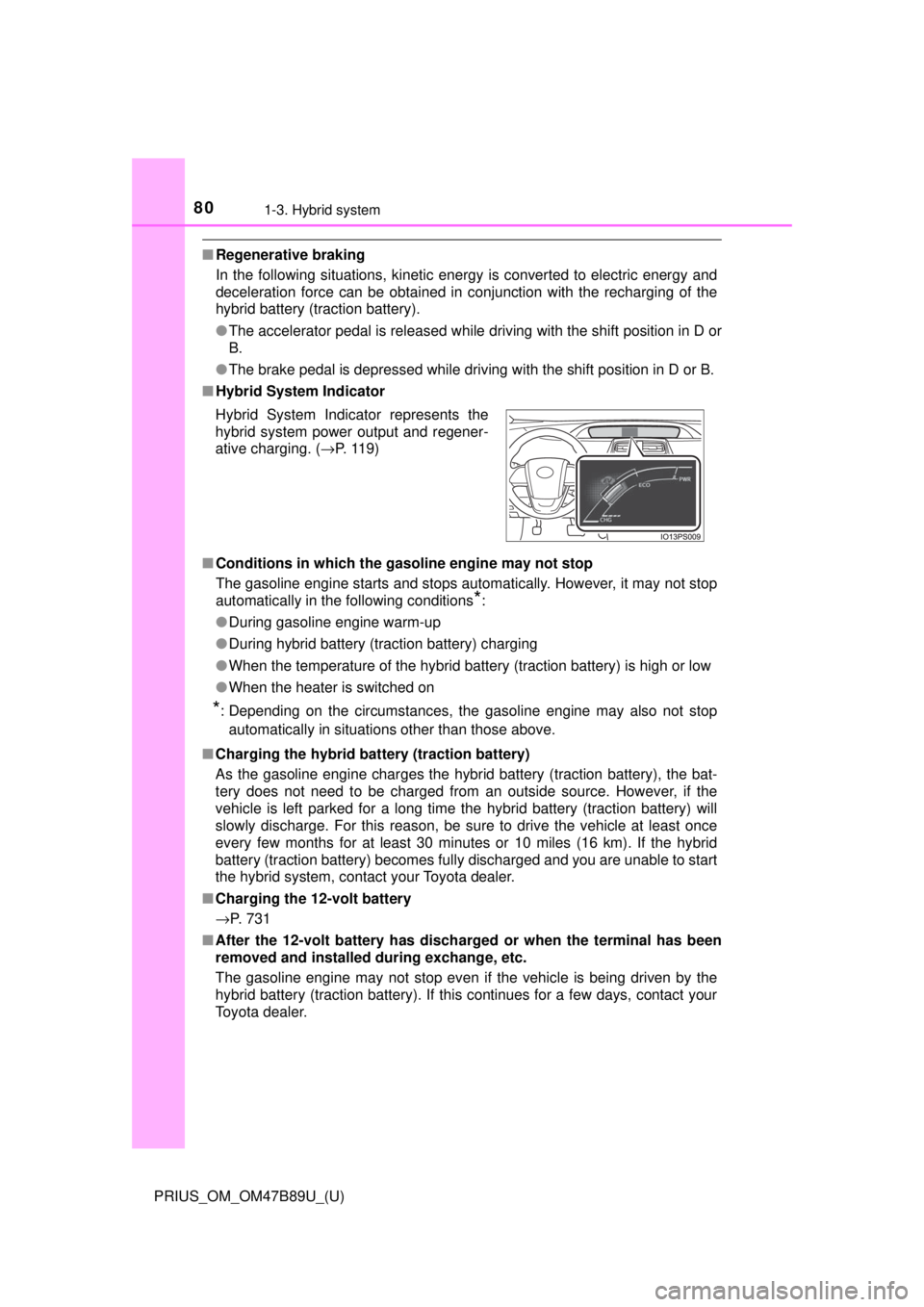
801-3. Hybrid system
PRIUS_OM_OM47B89U_(U)
■Regenerative braking
In the following situations, kinetic energy is converted to electric energy and
deceleration force can be obtained in conjunction with the recharging of the
hybrid battery (traction battery).
●The accelerator pedal is released while driving with the shift position in D or
B.
● The brake pedal is depressed while driving with the shift position in D or \
B.
■ Hybrid System Indicator
■ Conditions in which the gasoline engine may not stop
The gasoline engine starts and stops automatically. However, it may not stop
automatically in the following conditions
*:
● During gasoline engine warm-up
● During hybrid battery (traction battery) charging
● When the temperature of the hybrid battery (traction battery) is high or low
● When the heater is switched on
*: Depending on the circumstances, the gasoline engine may also not stop
automatically in situations other than those above.
■ Charging the hybrid battery (traction battery)
As the gasoline engine charges the hybrid battery (traction battery), the bat-
tery does not need to be charged from an outside source. However, if the
vehicle is left parked for a long time the hybrid battery (traction battery) will
slowly discharge. For this reason, be sure to drive the vehicle at least once
every few months for at least 30 minutes or 10 miles (16 km). If the hybrid
battery (traction battery) becomes fully discharged and you are unable to start
the hybrid system, contact your Toyota dealer.
■ Charging the 12-volt battery
→P. 731
■ After the 12-volt battery has dischar ged or when the terminal has been
removed and installed during exchange, etc.
The gasoline engine may not stop even if the vehicle is being driven by the
hybrid battery (traction battery). If this continues for a few days, contact your
Toyota dealer. Hybrid System Indicator represents the
hybrid system power output and regener-
ative charging. ( →P. 119)